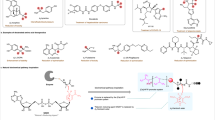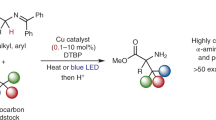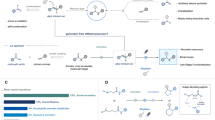Abstract
Amino acids are essential building blocks in biology and chemistry. Whereas nature relies on a small number of amino acid structures, chemists desire access to a vast range of structurally diverse analogues1,2,3. The selective modification of amino acid side-chain residues represents an efficient strategy to access non-canonical derivatives of value in chemistry and biology. While semisynthetic methods leveraging the functional groups found in polar and aromatic amino acids have been extensively explored, highly selective and general approaches to transform unactivated C–H bonds in aliphatic amino acids remain less developed4,5. Here we disclose a stepwise dehydrogenative method to convert aliphatic amino acids into structurally diverse analogues. The key to the success of this approach lies in the development of a selective catalytic acceptorless dehydrogenation method driven by photochemical irradiation, which provides access to terminal alkene intermediates for downstream functionalization. Overall, this strategy enables the rapid synthesis of new amino acid building blocks and suggests possibilities for the late-stage modification of more complex oligopeptides.
This is a preview of subscription content, access via your institution
Access options
Access Nature and 54 other Nature Portfolio journals
Get Nature+, our best-value online-access subscription
27,99 € / 30 days
cancel any time
Subscribe to this journal
Receive 51 print issues and online access
199,00 € per year
only 3,90 € per issue
Buy this article
- Purchase on SpringerLink
- Instant access to full article PDF
Prices may be subject to local taxes which are calculated during checkout





Similar content being viewed by others
Data availability
All data supporting the findings of this paper are available in the main text or the Supplementary Information.
References
Hruby, V. J. & Qian, X. in Peptide Synthesis Protocols (eds Pennington, M. W. & Dunn, B. M.) 249–286 (Humana, 1995).
Nájera, C. & Sansano, J. M. Catalytic asymmetric synthesis of α-amino acids. Chem. Rev. 107, 4584–4671 (2007).
Almhjell, P. J., Boville, C. E. & Arnold, F. H. Engineering enzymes for noncanonical amino acid synthesis. Chem. Soc. Rev. 47, 8980–8997 (2018).
deGruyter, J. N., Malins, L. R. & Baran, P. S. Residue-specific peptide modification: a chemist’s guide. Biochemistry 56, 3863–3873 (2017).
Noisier, A. F. M. & Brimble, M. A. C–H functionalization in the synthesis of amino acids and peptides. Chem. Rev. 114, 8775–8806 (2014).
Walsh, C. T., O’Brien, R. V. & Khosla, C. Nonproteinogenic amino acid building blocks for nonribosomal peptide and hybrid polyketide scaffolds. Angew. Chem. Int. Ed. Engl. 52, 7098–7124 (2013).
Blaskovich, M. A. T. Unusual amino acids in medicinal chemistry. J. Med. Chem. 59, 10807–10836 (2016).
Hickey, J. L., Sindhikara, D., Zultanski, S. L. & Schultz, D. M. Beyond 20 in the 21st century: prospects and challenges of non-canonical amino acids in peptide drug discovery. ACS Med. Chem. Lett. 14, 557–565 (2023).
Reetz, M. T. New approaches to the use of amino acids as chiral building blocks in organic synthesis. Angew. Chem. Int. Ed. Engl. 30, 1531–1546 (1991).
Rezhdo, A., Islam, M., Huang, M. & Van Deventer, J. A. Future prospects for noncanonical amino acids in biological therapeutics. Curr. Opin. Biotechnol. 60, 168–178 (2019).
Saleh, A. M., Wilding, K. M., Calve, S., Bundy, B. C. & Kinzer-Ursem, T. L. Non-canonical amino acid labeling in proteomics and biotechnology. J. Biol. Eng. 13, 43 (2019).
Lugtenburg, T., Gran-Scheuch, A. & Drienovská, I. Non-canonical amino acids as a tool for the thermal stabilization of enzymes. Protein Eng. Des. Sel. 36, gzad003 (2023).
Aguilar Troyano, F. J., Merkens, K., Anwar, K. & Gómez‐Suárez, A. Radical‐based synthesis and modification of amino acids. Angew. Chem. Int. Ed. Engl. 60, 1098–1115 (2021).
Boutureira, O. & Bernardes, G. J. L. Advances in chemical protein modification. Chem. Rev. 115, 2174–2195 (2015).
Capecchi, A. & Reymond, J.-L. Peptides in chemical space. Med. Drug Discov. 9, 100081 (2021).
Voica, A.-F., Mendoza, A., Gutekunst, W. R., Fraga, J. O. & Baran, P. S. Guided desaturation of unactivated aliphatics. Nat. Chem. 4, 629–635 (2012).
Herbort, J. H., Bednar, T. N., Chen, A. D., RajanBabu, T. V. & Nagib, D. A. γ C–H functionalization of amines via triple H-atom transfer of a vinyl sulfonyl radical chaperone. J. Am. Chem. Soc. 144, 13366–13373 (2022).
Chuentragool, P., Parasram, M., Shi, Y. & Gevorgyan, V. General, mild, and selective method for desaturation of aliphatic amines. J. Am. Chem. Soc. 140, 2465–2468 (2018).
Wang, K. et al. Selective dehydrogenation of small and large molecules by a chloroiridium catalyst. Sci. Adv. 8, eabo6586 (2022).
Dobereiner, G. E. & Crabtree, R. H. Dehydrogenation as a substrate-activating strategy in homogeneous transition-metal catalysis. Chem. Rev. 110, 681–703 (2010).
Choi, J., MacArthur, A. H. R., Brookhart, M. & Goldman, A. S. Dehydrogenation and related reactions catalyzed by iridium pincer complexes. Chem. Rev. 111, 1761–1779 (2011).
Parasram, M., Chuentragool, P., Wang, Y., Shi, Y. & Gevorgyan, V. General, auxiliary-enabled photoinduced Pd-catalyzed remote desaturation of aliphatic alcohols. J. Am. Chem. Soc. 139, 14857–14860 (2017).
Stateman, L. M., Dare, R. M., Paneque, A. N. & Nagib, D. A. Aza-heterocycles via copper-catalyzed, remote C–H desaturation of amines. Chem 8, 210–224 (2022).
Zhou, S., Zhang, Z.-J. & Yu, J.-Q. Copper-catalysed dehydrogenation or lactonization of C(sp3)–H bonds. Nature 629, 363–369 (2024).
West, J. G., Huang, D. & Sorensen, E. J. Acceptorless dehydrogenation of small molecules through cooperative base metal catalysis. Nat. Commun. 6, 10093 (2015).
Ritu, Kolb, D., Jain, N. & König, B. Synthesis of linear enamides and enecarbamates via photoredox acceptorless dehydrogenation. Adv. Synth. Catal. 365, 605–611 (2023).
Ravelli, D., Fagnoni, M., Fukuyama, T., Nishikawa, T. & Ryu, I. Site-selective C–H functionalization by decatungstate anion photocatalysis: synergistic control by polar and steric effects expands the reaction scope. ACS Catal. 8, 701–713 (2018).
Zhao, H. et al. Merging halogen-atom transfer (XAT) and cobalt catalysis to override E2-selectivity in the elimination of alkyl halides: a mild route toward contra-thermodynamic olefins. J. Am. Chem. Soc. 143, 14806–14813 (2021).
Occhialini, G., Palani, V. & Wendlandt, A. E. Catalytic, contra-thermodynamic positional alkene isomerization. J. Am. Chem. Soc. 144, 145–152 (2022).
Yamase, T., Takabayashi, N. & Kaji, M. Solution photochemistry of tetrakis(tetrabutylammonium) decatungstate(VI) and catalytic hydrogen evolution from alcohols. J. Chem. Soc. Dalton Trans. https://doi.org/10.1039/DT9840000793 (1984).
Wrzyszczyński, A. et al. Unexpected Hofmann elimination in the benzophenone−(phenylthio)acetic tetrabutylammonium salt photoredox system. J. Am. Chem. Soc. 125, 11182–11183 (2003).
Fuse, H., Kojima, M., Mitsunuma, H. & Kanai, M. Acceptorless dehydrogenation of hydrocarbons by noble-metal-free hybrid catalyst system. Org. Lett. 20, 2042–2045 (2018).
Zhou, M.-J., Zhang, L., Liu, G., Xu, C. & Huang, Z. Site-selective acceptorless dehydrogenation of aliphatics enabled by organophotoredox/cobalt dual catalysis. J. Am. Chem. Soc. 143, 16470–16485 (2021).
Zhang, Y.-A. et al. Stereochemical editing logic powered by the epimerization of unactivated tertiary stereocenters. Science 378, 383–390 (2022).
Halperin, S. D., Fan, H., Chang, S., Martin, R. E. & Britton, R. A convenient photocatalytic fluorination of unactivated C–H bonds. Angew. Chem. Int. Ed. Engl. 53, 4690–4693 (2014).
Yuan, Z. et al. Site‐selective, late‐stage C–H 18F‐fluorination on unprotected peptides for positron emission tomography imaging. Angew. Chem. Int. Ed. Engl. 57, 12733–12736 (2018).
Bogart, J. W. & Bowers, A. A. Dehydroamino acids: chemical multi-tools for late-stage diversification. Org. Biomol. Chem. 17, 3653–3669 (2019).
Edagwa, B. J. & Taylor, C. M. Peptides containing γ,δ-dihydroxy-l-leucine. J. Org. Chem. 74, 4132–4136 (2009).
McLean, J. T., Milbeo, P., Lynch, D. M., McSweeney, L. & Scanlan, E. M. Radical‐mediated acyl thiol‐ene reaction for rapid synthesis of biomolecular thioester derivatives. Eur. J. Org. Chem. 2021, 4148–4160 (2021).
Wakimoto, T. et al. Proof of the existence of an unstable amino acid: pleurocybellaziridine in Pleurocybella porrigens. Angew. Chem. Int. Ed. Engl. 50, 1168–1170 (2011).
Zwick, C. R. & Renata, H. Remote C–H hydroxylation by an α-ketoglutarate-dependent dioxygenase enables efficient chemoenzymatic synthesis of manzacidin C and proline analogs. J. Am. Chem. Soc. 140, 1165–1169 (2018).
Tao, H. et al. Stereoselectivity and substrate specificity of the FeII/α-ketoglutarate-dependent oxygenase TqaL. J. Am. Chem. Soc. 144, 21512–21520 (2022).
Gomez, C. A., Mondal, D., Du, Q., Chan, N. & Lewis, J. C. Directed evolution of an iron(II)‐ and α‐ketoglutarate-dependent dioxygenase for site-selective azidation of unactivated aliphatic C–H bonds. Angew. Chem. Int. Ed. Engl. 62, e202301370 (2023).
Nanjo, T., De Lucca, E. C. & White, M. C. Remote, late-stage oxidation of aliphatic C–H bonds in amide-containing molecules. J. Am. Chem. Soc. 139, 14586–14591 (2017).
Sarver, P. J., Bissonnette, N. B. & MacMillan, D. W. C. Decatungstate-catalyzed C(sp3)–H sulfinylation: rapid access to diverse organosulfur functionality. J. Am. Chem. Soc. 143, 9737–9743 (2021).
Galonić, D. P., Vaillancourt, F. H. & Walsh, C. T. Halogenation of unactivated carbon centers in natural product biosynthesis: trichlorination of leucine during barbamide biosynthesis. J. Am. Chem. Soc. 128, 3900–3901 (2006).
Cudic, M., Marí, F. & Fields, G. B. Synthesis and solid-phase application of suitably protected γ-hydroxyvaline building blocks. J. Org. Chem. 72, 5581–5586 (2007).
Shu, C., Noble, A. & Aggarwal, V. K. Metal-free photoinduced C(sp3)–H borylation of alkanes. Nature 586, 714–719 (2020).
Barbie, P. & Kazmaier, U. Total synthesis of cyclomarins A, C and D, marine cyclic peptides with interesting anti-tuberculosis and anti-malaria activities. Org. Biomol. Chem. 14, 6036–6054 (2016).
Agami, C. et al. Asymmetric syntheses of enantiopure 4-substituted pipecolic acid derivatives. Eur. J. Org. Chem. 2001, 2385–2389 (2001).
Ferraboschi, P., Mieri, M. D., Grisenti, P., Lotz, M. & Nettekoven, U. Diastereoselective synthesis of an argatroban intermediate, ethyl (2R,4R)-4-methylpipecolate, by means of a mandyphos/rhodium complex-catalyzed hydrogenation. Tetrahedron Asymmetry 22, 1626–1631 (2011).
Smaligo, A. J. et al. Hydrodealkenylative C(sp3)–C(sp2) bond fragmentation. Science 364, 681–685 (2019).
Acknowledgements
We thank J. Yang (MIT) for HPLC separation of product 2p and S. Garhwal (MIT) for supercritical fluid chromatography data collection. Financial support for this work was provided by the National Institutes of Health (GM146248) and the National Science Foundation (NSF) through a Graduate Research Fellowship to G.O. (DGE1745303).
Author information
Authors and Affiliations
Contributions
A.E.W., X.G. and Y.-A.Z. conceived the work, designed experiments and analysed the data. L.W. and S.Z. contributed equally to substrate synthesis and characterization. X.Y. and B.L.P. provided expertise on the synthesis and analysis of oligopeptides. G.O. and J.B. performed exploratory experiments establishing the feasibility of terminal-selective aliphatic dehydrogenation. A.E.W., X.G. and Y.-A.Z. drafted the manuscript with input from all authors. A.E.W. directed the research. All authors have given approval to the final version of the manuscript.
Corresponding author
Ethics declarations
Competing interests
The authors declare no competing interests.
Peer review
Peer review information
Nature thanks Jonathan Clayden, Christopher Teskey and the other, anonymous, reviewer(s) for their contribution to the peer review of this work.
Additional information
Publisher’s note Springer Nature remains neutral with regard to jurisdictional claims in published maps and institutional affiliations.
Supplementary information
Supplementary Information
This file contains Supplementary Information; for details, see Table of Contents.
Rights and permissions
Springer Nature or its licensor (e.g. a society or other partner) holds exclusive rights to this article under a publishing agreement with the author(s) or other rightsholder(s); author self-archiving of the accepted manuscript version of this article is solely governed by the terms of such publishing agreement and applicable law.
About this article
Cite this article
Gu, X., Zhang, YA., Zhang, S. et al. Synthesis of non-canonical amino acids through dehydrogenative tailoring. Nature 634, 352–358 (2024). https://doi.org/10.1038/s41586-024-07988-8
Received:
Accepted:
Published:
Issue Date:
DOI: https://doi.org/10.1038/s41586-024-07988-8
This article is cited by
-
Strategic atom replacement enables regiocontrol in pyrazole alkylation
Nature (2025)
-
Reshaping amino acids
Nature Synthesis (2024)



